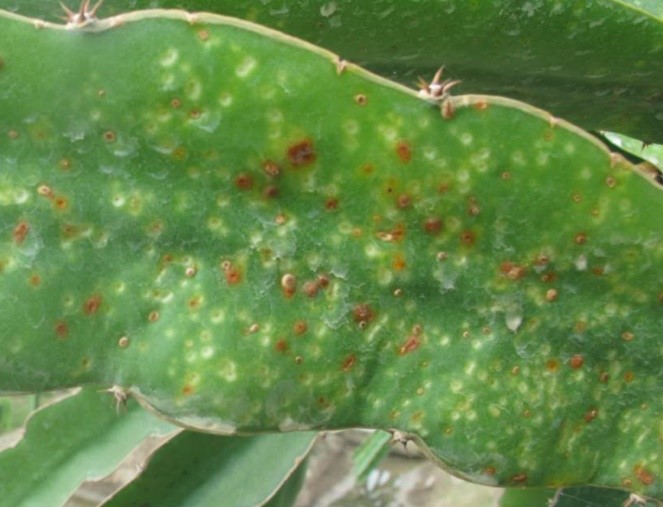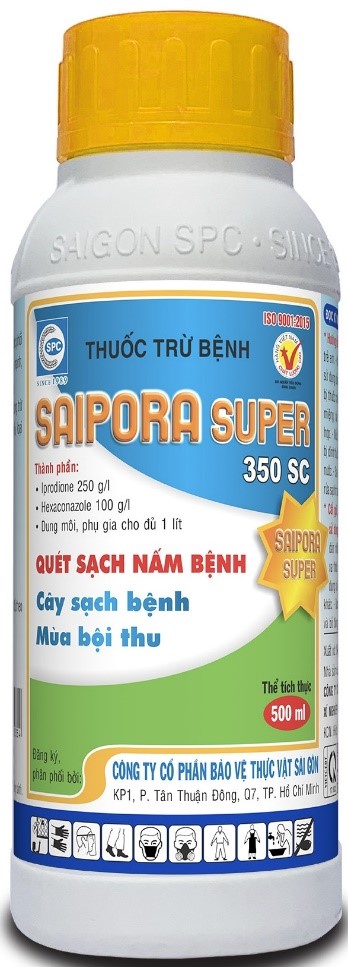|
DRAGON FRUIT BROWN SPOT DISEASE
21/06/2023
DRAGON FRUIT BROWN SPOT DISEASE 22/09/2022 Dragon fruit is one of the crops with high economic value. Dragon fruit has been exported and is popularly used by society in the form of fresh fruit. However, in the process of producing dragon fruit, farmers often face many pests and diseases. In particular, brown spot disease (gecko fungus) is one of the most dangerous diseases with dragon fruit. Brown spot disease can cause crop failure, fruit difficult to export. Diseases also increase costs and hinder production for farmers. * Symptoms and effects: The disease usually affects the young parts of the plant, then can also spread to the parts are neither old nor young. On young branches, the initial lesions are tiny circles, concave, then after a few days, the lesions turn white, then lemon yellow, in the middle of the disease there is a brown spot, then The entire lesion turns a slightly raised round brown color. When the disease is severe, many diseases link together causing large rotten patches on dragon fruit branches. On young fruit, the disease causes similar damage. The disease causes fruit rot, affecting fruit yield and quality. The most dangerous thing is that the fruit becomes unsightly, devalued and cannot be exported. * Pathogens and suitable conditions for development: The disease is caused by the Neoscytalidium sp fungus. cause. The disease often arises and thrives in the stage of young shoots, and young fruits in the rainy season, or a lot of fog, high air humidity, and little sunshine are optimal conditions for the disease to develop… the remnants in the garden are not cleaned up, do not cut and destroy diseased branches. The garden creates canopy so that the branches are too thick, fertilize unbalanced, excess nitrogen, lack of organic and medium, micro-nutrients. The garden does not manage water well, making the garden often wet. The use of contaminated water for irrigation and spraying also facilitates disease spread. * Effective prevention measures: It is necessary to apply many measures at the same time as well as to prevent the whole area at the same time. - Need to plant appropriate density and create canopy to ensure ventilation. - After harvesting, it is necessary to clean the remains of the previous crop, prune the diseased branches and remove them from the garden to destroy and clear large trees to shade around the garden. Ventilation also makes spraying easier, increasing efficiency. - Do not use water in neighboring ditches or furrows to spray or irrigate dragon fruit. - Raise high beds and water appropriately so that the garden is not wet often. - Apply balanced fertilizer, have enough organic fertilizer that has been thoroughly composted with the Trichoderma antagonistic fungus, supplemented with secondary and trace elements to help increase the resistance of plants such as TANO-601 foliar fertilizer before and during the branching and fruiting stages Periodic lime should be applied to the soil to reduce acidity and disinfect the soil. - Do not stimulate excessive off-season flowering. It is necessary to have the right care regime so that the tree is not exhausted, which reduces its resistance to pests and diseases. - When the disease has just appeared, or before, during and after the appearance of young shoots and fruits, or when the weather conditions are rainy, cloudy, less sunny, or foggy, humid air, it is necessary to alternate prevention with products: SAIPORA SUPER 350SC, SAGOPERFECT 320SC. Should spray 2-3 times 4-5 days apart, depending on the conditions of the garden and weather. When spraying, pay attention to spray evenly throughout the canopy, especially below and in the canopy.
|
To prevent, in addition to plowing and burying weed seeds, collecting weed stalks and stumps left after tilling the land to burn, not letting weeds produce seeds in production fields, etc., the use of chemical products is still a measure. optimal because of its ability to thoroughly kill weeds, reduce labor and take advantage of more time than manual weeding.
Miner has the scientific name Phyllocnistis citrella Staint., family Phyllocnistidae, order Lepidoptera. The miner occurs in many countries in the tropics and subtropics. The main host of the miner is the citrus family - Rutaceae. In addition, the miner also attacks mangosteen and some other plants.
Adult is a small planthopper, with a body 2-3 mm long, the whole body is ash gray, slightly greenish, the wings are opaque with many small brown spots.Eggs are oval, 0.3 mm long, have a pointed end and are attached directly to the leaf surface, leaf axils.
Green bugs specialize in the fruit of citrus groups (oranges, tangerines, lemons, grapefruits, kumquats...), some people call them orange bugs, or orange suckers. Their scientific name is Rhynchocoris poseidon or Rhynchocoris humeralis.
In Vietnam, yellow leaf curl disease is very common on papaya trees, especially the disease is often severe in areas of high and continuous planting, areas with hot and arid climates. The disease has significantly reduced the yield and quality of papaya. Gardens that are infected early when the plants are young may not yield. However, up to now, many gardeners still do not know the cause and how to fix it.
Spider mites are common pests on citrus trees, especially in hot and dry climates that are suitable for spiders to grow and cause severe damage.The group of harmful spiders is usually very small in size, unlike the natural enemy spiders.
This group includes species that are generally very small in size, causing damage by sucking plant sap (on leaves, fruits, branches, stems).
There are many species of mealybugs present on the group of Oranges,Tangerines,Grapefruits and Lemons (Citrus), which can be divided into 2 groups:
+ Group of sticky mealybugs with common varieties such as Lepidosaphes, Aonidiella, Coccus and Saissetia.
+ Group of flower mealybugs with common genera and species such as Pseudococcus, Planococcus and Icerya purchasi.
Dry branches and berries disease often appear to be common damage on coffee gardens during the rainy season. The disease causes death of branchs, dry fruit, severely affects the canopy structure and coffee yield if not paid attention to prevention.
Pink disease commonly causes diseases on rubber plantations in the rainy season, especially on garden from 4-8 years old. This year, rubber has to go through a period of severe drought, weakening the tree, so now in tnshe rainy season it is easy to get infected. Therefore, it is necessary to pay attention to good management to avoid affecting the garden.
In recent years, the area of citrus has been expanded because it is a fruit tree with high economic efficiency. However, in order to sell at a high price, not only in quality but consumers also require the external beauty of the fruit, so pest management on citrus is a matter of great concern to farmers. The hot season is a favorable condition for thrips to develop and cause damage, affecting the commercial value of fruit.
- Headquarters
- SAIGON PLANT PROTECTION JOINT STOCK COMPANY
- RQ 1, Nguyen Van Quy St., Tan Thuan Ward, HCM City
- Tax code: 0300632232
- Tel: (028) 38 733 295 - 38 732 077
- Fax: (028) 38 733 003 - 38 733 391
- Website: www.spchcmc.vn - Email: info@spchcmc.vn
- SAIGON PLANT PROTECTION COMPANY
- SAIGON PLANT PROTECTION JOINT STOCK ENTERPRISE
- Lot C1-C3 Hiep Phuoc Industrial Park, Hiep Phuoc Commune, HCM City
- Tel: (028) 3873 4089 - Fax: (028) 3873 4086
- Affiliated Unit
-
- Quick Links
- Home
- About us
- Career Opportunities














